Televisions have become an indispensable element of our daily life. It demonstrates togetherness by displaying our favorite content on a large screen when we return home from a long day. You can get an excellent TV for under $1500 these days.
The best 75-inch tv under 1500 dollars has really become easy. New technology features are making their way into more common models, making them more accessible to a broader range of people, especially now that you can purchase a good TV for a lower price.
If you’re prepared to compromise on size, you can find some high-end TVs with superb picture quality and features for around $1,500. You may be confined to a 55 or 65-inch screen, but a few entry-level models are available in a 75-inch size. Sports, news, live channels, recipes, and TED speeches are all available with a single click.
Furthermore, televisions have come a long way and are now enormous, including cutting-edge technology to make our lives easier and more entertaining.
Similarly, the best 75-inch TV under 1500 dollars is no longer a pipe dream for those who believe that large-screen TVs are prohibitively expensive because all of the products we will discuss in this article will astound you with their features, design, and magical abilities to deliver stunning content, outstanding audio quality, and so on.
Don’t forget to bring along a tiny buyer’s guide to assist you in making an informed selection about this necessary purchase. There are a lot of TVs on the market these days, but finding a decent one might be difficult.
It’s not simple to locate an affordable TV that produces excellent images. Purchasing the best 75-inch television under 1500, on the other hand, is a significant investment. As a result, you must ensure that you purchase the correct television.
We have compiled the list of the best 75-inch tv under 1500 dollars, which can specifically meet your needs and fit your budget.
The buying guide on the best 75-Inch TV under 1500 Dollars:
Getting a smart TV doesn’t have to be on your grocery list every other day, and maintaining it shouldn’t be on your to-do list. So here are some important points to know when buying a TV.
If your goal is for the next weekend, it’s hard to get the best 75-inch TV, but don’t worry. All the above product reviews will help you become familiar with some of the best TVs available on the market for this budget.
Resolution of television
There are many numbers and letters that professionals use to describe TV resolutions. Still, your concern is that you need to know the best trend and the right resolution type for you. In general, resolution complements the brightness displayed on a television.
It consists of a series of pixels that improve image quality and reward the clarity and clarity of the content being played. If your TV offers 4K resolution, it has about 3,840 x 2160 pixels. This is a pretty big problem and should be available soon. People also call it 4K resolution UHD (Ultra High Definition), and the brand offers this number on all TVs with screen sizes larger than 50 inches.
Size of screen
So did you think of that sweet spot where you want to sit down and watch your favorite TV show? If you haven’t done so already, now is the right time to consider buying a 75-inch TV.
It’s a huge screen, so you need a great place to mount it on the wall. In addition, don’t face the problem of reflections and don’t forget to keep a good distance so that the content is perfectly reproduced from every angle.
Smart TV
Smart TVs have become a big deal these days, with exciting features. Integrated voice control and smart TV platforms are game-changers in the TV industry, and consumers enjoy them all.
The quick UI and clever features offer the sensation of using a phone with a huge screen. The Scepter 75-inch TV is a good choice if comfortable with Android. If you want to try something else, Samsung’s Tizen platform and LG ThinQAI WebOS are two options.
Connectivity
Do not reduce the number of ports. The more inputs you have on your TV, the more options you need to pair different digital devices. A 75-inch TV is great for watching old movies that require a DVD player to be connected.
HDMI input is sufficient to solve this problem. In addition, USB, optical digital inputs, composite and VGA inputs allow you to connect game consoles, PlayStations, laptops, and more.
HDMI seems to be the only connection you need to worry about. HDMI is an industrial interface for connecting media to a TV. B. Video services, Blu-ray discs, gaming systems, and even computers.
HDMI includes the appearance of the connector and many features that the connector may offer. With a few exceptions, you don’t have to worry about upgrading to HDMI 2.1. The above features, including VRR, are supported in HDMI 2.0b.
Design of television
Make sure the screen is curvy or rectangular in your layout. Examine the TV’s width as well. Another factor to keep under consideration is the width of the border. As a result, you can choose which one is best for you by examining edge thickness, screen thickness, and body thickness.
Monitor the availability as well. When analyzing your design, be sure to look at the mechanical properties. Examine the TV’s casing to see if it’s composed of plastic or metal. Furthermore, the screen is either matte or nearly fully matte.
In bright environments, the semi-glossy screen is ideal for reducing reflections. Last but not least, have a peek at the panel. There are two sorts of typical panels available right now. IPS and VA are two acronyms for Information Processing System and Virtual Assistant.
The VA panel has a greater colour dynamic range, whereas the IPS panel has a greater field of view. Please keep in mind that the VA panel’s observing distance is restricted.
Display technology
Whenever it is regarding smart TVs, the most crucial necessity is the display technology, and picking the proper alternative from a vast range of possibilities might be confusing. These smart TVs offer LED illumination, but you can upgrade to an OLED panel for a higher price. OLED televisions have great contrast and saturation levels, which helps to enhance dynamic range.
Such gadgets, nevertheless, are much more costly, and slower refreshing rates might cause computational efficiency to suffer. Many versions, on either hand, employ OLED screens, which I believe are better than OLEDs in every way. These QD LED panels are low-cost and aid with power economy, frame rate, and quicker work.
Furthermore, these improve the requisite picture quality, with the increased colour spectrum, brightness, and contrast levels. Those are noted for their voice quality, unaffected by ambient noise.
Contrast
High-frequency response is a method for extending the disparity between the cleanest white and the darkest black in a photograph. HDR screens, in general, are far more lifelike than standard visuals. In a nutshell, HDR TV provides superior visual quality. HDR10 is the industry standard for home televisions. This is an excellent platform.
Dolby Vision is a more advanced kind of HDR that can correlate dynamic features with basic imagery and instruct users on how to rebuild the frame precisely. To portray the picture appropriately, these instructions may be interpreted on a Dolby Visual acuity panel.
The Ultrathin Array function on some Samsung TV models increases the contrast in all conditions by carefully changing the illumination parameters. Images in black are darker, and sceneries in brighter colours are stronger.
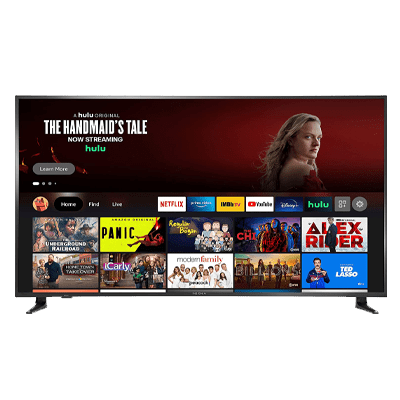
PROS
CONS
The Insignia NS75F301NA22 F30 is a 4k TV with nanostructured displays that give a broader colour spectrum than standard LED-backlit TVs. This is a basic television with a few extra functions.
The Display Technology panel has a large colour spectrum, but the intense colours are so hypotonic that they can’t be adequately depicted. VA panels are good for dark environments because they have a large dynamic range and black homogeneity, but they lack localized fading, a feature found in most minimal-cost TVs.
It’s also acceptable for fairly light environments, with the correct full intensity and decent reflectors inside the Hdr, but it can’t resist intense glare. Furthermore, because the viewing angle is small, the image degrades when moved away from the centre, reducing the availability of a large seating plan.
Ultimately, the Insignia F30 QLED is fantastic television. It is excellent for viewing movies and Television shows in dark rooms because of its clear contrast and black homogeneity.
However, there is no local dimming to boost the contrast. It has a decent gameplay experience with little input lag and a quick reaction time, but it lacks sophisticated gameplay features like higher refresh rate compatibility.
It can show a wide colour spectrum and implements HDR, but it isn’t bright enough to bring out little highlights. Thus it contributes relatively little HDR overall. The lettering is fuzzy, and the Chroma 4: 4: 4 signals cannot be shown accurately, reducing the availability for usage on desktop PCs.
A snappy desktop interface is provided with little input latency and incredible reaction speeds. It also has the proper reflections in a bright setting, so glare isn’t a concern. However, because Chromatic 4: 4: 4 transmission should be shown accurately, the information on the screen seems fuzzy. This is good for PC gaming, but it is not ideal for desktop usage due to this constraint.
Also Read: Best 19-Inch TV
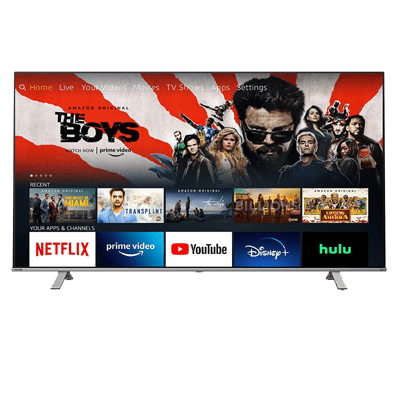
PROS
CONS
The Toshiba C350 Fire TV 2021 succeeds the Toshiba Fire TV 2020 as a basic entry Television. It runs on the Amazon Fire TV smart platform, which is easy to use and provides many apps.
If you wish to project information through the smartphone, it enables Apple Siri, but not Chromecast. It comes in various sizes, ranging from 43 to 75 inches; we examined the 55-inch version with an IPS-like screen, and the 50-inch version must have a VA display, but we’re not sure which screens have other dimensions.
Our item has a broad field of view but with contrast adjustment, making blacks seem grey, and no local dimming boosts contrast. It also lacks functionality, such as motion compensation, judder reduction, and a higher refresh rate. Generally, the Toshiba C350 performs admirably.
The 75-inch model we tested boasts an IPS-like display with wide viewing angles, making it suitable for watching tv shows or games in a large room. However, this means it has a low contrast, which is unpleasant when viewing movies; however, better contrast may be available in different sizes.
It can’t show a wide colour gamut and has a low HDR peak brightness, making it unsuitable for watching HDR movies. It’s adequate for gaming. However, it lacks any additional gaming capabilities.
It lacks the wide colour gamut required for HDR content and the brightness required to make highlights shine. Our TV has a poor contrast ratio, and while some other sizes may have VA screens with greater contrast, it lacks a local dimming capability that would allow us to enjoy the HDR content.
Also Read: Best 55-inch TV under 600 Dollars
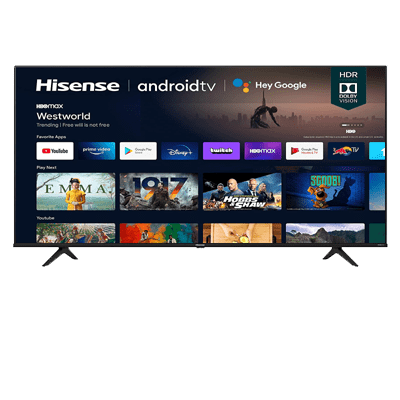
PROS
CONS
The Hisense 75A6G is a low-cost 4k television. The sizes range from 43 to 85 inches, and the precise specs differ depending on the size, which might be perplexing. We evaluated a gadget with an IPS display with a broad angle of view but poor contrast.
It also has poor black homogeneity and no local dimming, making it inappropriate for dimly lit areas. Some sizes feature a VA screen, which could raise productivity in dark spaces due to the high contrast, although they do not yet offer local fading.
The UI is incredibly user-friendly, and you have access to many smart apps. Also, the input latency is quite minimal whilst not in play mode, but the reaction time is somewhat slow, rendering it a gameplay TV.
Ultimately, the Hisense A6G is excellent television. Daytime presentations benefit from a broad viewing angle and correctly reflect the correction, but they may not be bright enough to counteract the brightness of a bright environment. Despite minor latency, the game isn’t known for it.
There are no sophisticated gaming options, and the refresh rate is poor. Avoid devices with IPS panels if you enjoy viewing movies in the dark. It features a poor contrast, black homogeneity below normal, and no shading capability.
The dynamic range is poor, the black uniformity of the tested units is below standard, and black looks grey in gloomy settings. Because there is no shading feature, none of it can be enhanced.
Native applications or native 24p streams, on either hand, can appropriately upgrade reduced material and remove jitter. Because of the great contrast and likely high black consistency, the VA panel’s size should be considerably better with film.
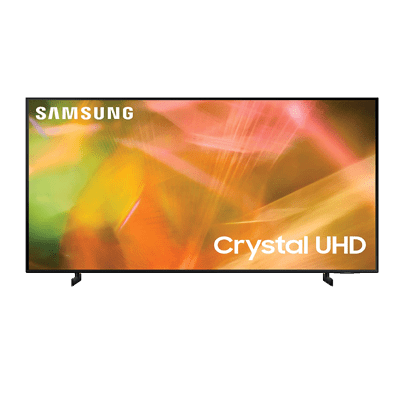
PROS
CONS
The Samsung AU8000 is a fantastic gaming television. This simple device lacks features like variable frame rates and HDMI 2.1 support, but that’s to be expected from a low-cost alternative. VA-like panels function best in dark spaces because of their high natural contrast ratio.
However, there is not any other way to raise the dark level by using local dimming. It improves on the predecessor in certain ways, such as superior reflection handling, but it doesn’t grow much brighter, making it a decent option for low-light situations. Unfortunately, it is not recommended for big seating arrangements. This is due to the limited viewing angle, which causes the image to seem faded from the side.
The Samsung AU8000 is ideal for gaming. Relatively low latency is required for a speedy gameplay experience. However, there are no capabilities such as VRR support, and the reaction time is poor, resulting in fuzzy movements.
On the plus side, the high contrast ratio makes it perfect for gaming in gloomy settings. Even though no regional darkening is provided to improve contrast, it has a naturally high dynamic range, perfect for viewing movies.
Its outstanding reflective handling makes it ideal for watching TV shows and games, but its restricted field of view precludes it from being used in large sitting areas.
HDR games are compatible with the AU8000. The input lag in the game is minimal, but the system response is slow, and VRRs is not endorsed. On the other hand, HDR material does not appear attractive since it lacks a colour range gamut and has a low lumen output.
As a result, the highlights will not be communicated effectively. The inherent contrast is high, but there is no way to boost it with local dimming. Although response times are sluggish and motions are smudged, input latency is minimized, resulting in a responsive gaming experience. Sadly, it can’t show HDR video’s colour range, and it’s too dark to pull out the peaks.
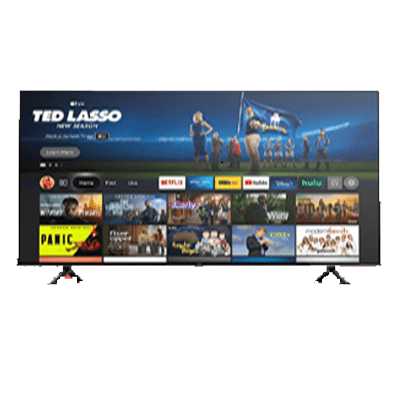
PROS
CONS
To enhance the rather minimalist look, Omni employs some all-around chrome borders. A virtually invisible black border surrounds the screen, giving it an almost borderless look. It has a bottom border, a silvery stripe in the middle with the Amazon Fire symbol, and a little shelf beneath it with a relatively close mic.
The TV may be ceiling or standing on two broad aluminium legs in a V-shape. The power cable is already on the left side of the back panel, and all other connections will be on the right. THE OPTIONS ARE four HDMI ports, a USB 2.0 port, an audio production, a network adapter, and a wired port.
It connects multiple apps and services to an Amazon-centric experience with many features. Amazon Prime Video is, of course, integrated into the platform. Apple, Disney +, Directv Plus, Youtube, Spotify, Vimeo, and Dailymotion, among other non-streaming platforms, are also accessible.
Streaming live TV providers, Internet channels, and platforms that show PlutoTV channels all have live recommendations integrated. When it comes to mirroring, Fire TV falls below Google TV and Roku TV. WiDi/Miracast can be used to mirror your computer monitor. However, there is no Mac Airplay or Android Chromecast to make reflecting your mobile or PC simple and quick.
Overall, the Amazon Fire TV Omni Series is a decent television. It’s ideal for watching movies in a dark room since it offers excellent contrast. The top-notch want to gaze at the television in a gleaming environment.
However, this is no longer suitable for sports or video games due to the slow reaction time. Unfortunately, HDR can’t get extremely glossy, and it can’t show a wide colour range, so it’s almost useless in video games and movies. Finally, it is no longer recommended for PC use due to unclear text information.
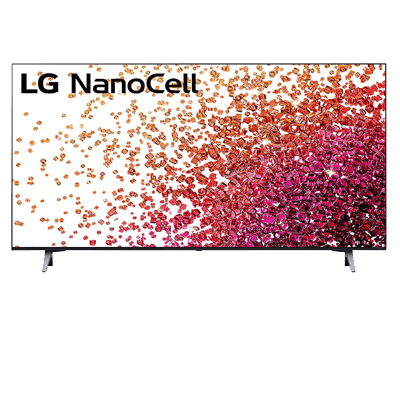
PROS
CONS
This model from the LG series is a good one with exciting features. However, the 75-inch screen size is the talk of the town because it looks great in living rooms and allows you to watch others work in the kitchen or read while lounging on a sofa.
So you won’t miss out on your favorite shows even if you’re cleaning the house; the content is easy to watch from any angle. We may enjoy a detailed LED picture of 4K quality with the LG 75NANO90UPA.
You’ll see deep blacks and contrast with finely adjusted illumination that reduces the halo effect and light bleed with Full Array Dimming. See Nano Color’s natural, lifelike image and the quick action of a 120Hz refresh rate.
The LG NanoCell TV filters and refines color by removing pollutants from RGB wavelengths using nanoparticles, our exclusive Nanotechnology. This implies that only pure, correct colors will be displayed on the screen. As a result, your material will come to life with a more bright, more realistic image.
The front, on the other hand, is decent but appealing. HDMI, RC-232, USB 2.0, Digital optical audio output, USB Type-A, composite audio and video input, and a 3.5mm small audio connector are all found on the back panel. One of the HDMI inputs, surprisingly, supports the HDCP 2.2 standard. It also boasts Bluetooth 5.0 compatibility, allowing you to connect your phones and external speakers and play music during your party nights.
The WiFi connection should come as no surprise given that it is a Smart TV. The LG ThinQ AI WebOS, on the other hand, might catch your eye. It’s the most user-friendly UI I’ve seen, and the on-screen menu is simple to navigate.
Accessing internet platforms, downloading apps, and diving into such things are all comparable to what you do on your smartphone. It does, however, come with a remote control that aids navigation, but you can also take advantage of the built-in Voice control assistants to operate your TV for you.
The a9 Gen 2 intelligent 8K processor in this most OK 75-inch TV under 1500 converts everything you view on-screen into the highest quality with rich color and precise details delivery.
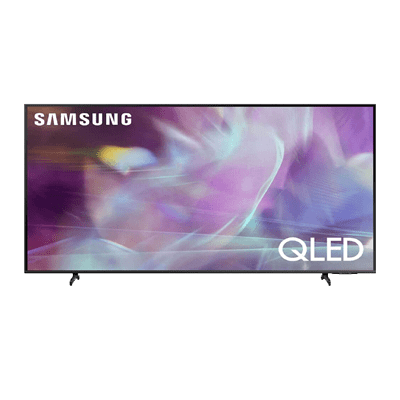
PROS
CONS
Overall, the Samsung Q60A is good television. In bright environments, it gives excellent vision, which is ideal for viewing TV shows or sports. However, it’s not ideal for viewing with a large group in a large seating arrangement because of the narrow viewing angles.
It boasts extremely low input lag for gaming and a PC monitor. However, some users may be disappointed by its 60Hz refresh rate, slightly poor response time, and lack of variable refresh rate capability.
Unfortunately, although having a high contrast ratio and a wide color gamut, it lacks local dimming and does not reach bright enough to provide a real HDR movie experience.
The most noticeable difference is that it’s a lot thinner, which means it won’t protrude as much when placed on the wall. The feet may now be adjusted in height, allowing you to lift the TV higher if you need more space for a soundbar.
The build quality is decent. Its all-plastic build isn’t particularly luxurious, but it’s reasonably durable and doesn’t wobble much. At the bottom left corner, there’s a slight gap between the border and the screen, but this could be our unit, and it’s not awful enough to be a dealbreaker.
However, it lacks most of Samsung’s higher-end gaming and motion enhancement features. It boasts a low input lag and a decent response time. However, its HDMI ports only support HDMI 2.0 bandwidth, frustrating for PS5 and Xbox Series X gamers. It uses a somewhat simplified version of Samsung’s intelligent OS Tizen interface, with fewer animations in general.
It is, however, still quite user-friendly, and it offers a large number of streaming apps. Unfortunately, it has poor viewing angles, making it unsuitable for a large seating arrangement. It also has limited HDR support, with no local dimming and low peak brightness when playing HDR content.
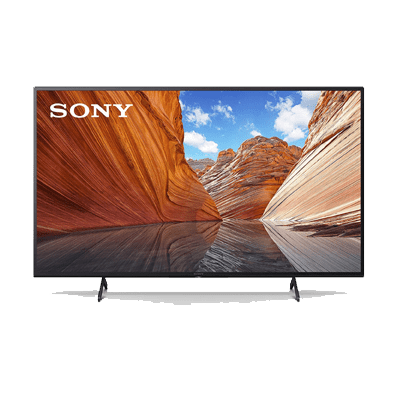
PROS
CONS
The Sony X80J is a 4K TV part of Sony’s 2021 portfolio. It lacks many capabilities seen on higher-end TVs, yet it works admirably for a budget IPS model. Because of the low contrast ratio of its ADS panel, blacks seem grey in a dark room, and it lacks a local dimming feature to increase black levels.
It does, however, have excellent wide viewing angles and gets bright enough to prevent glare in moderately lit settings. While it offers a large color gamut for HDR video, it cannot become bright enough to bring out highlights in HDR, limiting the overall HDR experience.
The Sony X80J appears to be well-made. The TV is entirely composed of plastic and is relatively light. However, it lacks the durability of higher-end televisions. There’s a lot of flex on the rear and around the edges.
On the bottom left side of the screen, there appear to be two little white squares where the panel meets the border of our device. However, we believe that this is a problem unique to our unit and has no bearing on scoring.
Unfortunately, the Sony X80J has poor contrast, making blacks appear grey in dim lighting. There’s also no local dimming to help with contrast. In SDR, the Sony X80J provides adequate brightness. It’s not as bright as the Sony X800H, but it’s bright enough to eliminate glare in modestly lit areas with few windows.
The brightness is reasonably consistent across diverse scenarios, but the 2 percent window is darker due to the TV’s frame darkening. The Sony X80J’s HDR brightness is subpar. It’s brighter than SDR but not bright enough to make highlights stand out.
However, the EOTF follows the target rather closely, implying that the overall brightness of situations is reasonably accurate. The dirty screen effect is minimal throughout the center, ideal for watching sports. The homogeneity is considerably better in near-dark settings, with no visible flaws.
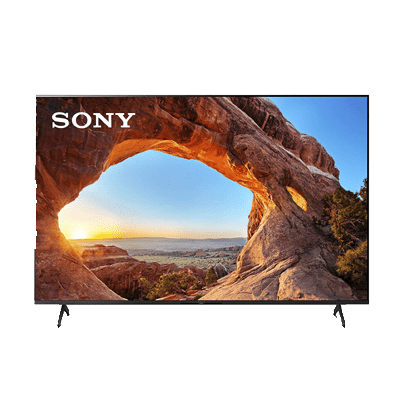
PROS
CONS
In Sony’s 2021 portfolio, the X85J is a mid-range 4k TV. It’s a replacement for the Sony X85H, never sold in North America; the Sony X850G was the closest model we tested. It’s a good TV with excellent dark room performance because of its high contrast ratio and black uniformity.
It’s ideal for bright spaces because it has a high peak brightness and good reflection handling, so glare isn’t an issue unless there’s a lot of natural light. It uses the redesigned Google TV interface, comparable to the Android TV interface present on prior Sony TVs but is more user-friendly.
It offers the same fantastic range of streaming apps, so you’ll have no trouble finding what you’re looking for best streaming service. After a firmware upgrade, gamers will love the reduced input lag, HDMI 2.1 bandwidth, and variable refresh rate (VRR) support.
Unfortunately, there is no local dimming feature to boost contrast in tragic scenes. The Sony X85J has a simple yet attractive appearance. It doesn’t have the same quality appearance as the Sony X90J, and it’s mostly made of plastic, yet it fits in with most decors. The inputs are on the side, which is convenient if installing them on the wall.
In HDR, the Sony X85J offers a good peak brightness. With most programming, it’s bright enough to give an impact HDR experience, but little highlights don’t pop out as brightly as the director intended.
The Sony X85J handles reflections well. The semi-gloss coating softens direct reflections slightly without smearing them over the screen. Although bright lights can be distracting, we don’t expect visibility to be an issue in most situations. The remote contains a built-in microphone for voice control, but this feature requires pairing with the TV through Bluetooth.
Voice commands function nicely, allowing you to switch inputs, search for content, and modify some settings. Overall, this great TV is reasonably priced at about 1500 dollars, allowing you to entertain without breaking the bank, so consider it.
Also Read: Best TV under $700
Conclusion:
The market is flooded with fantastic Smart TV alternatives as firms continue to release new models, but choosing the right combination of decent design, flexible connectivity, and appealing features may be difficult, especially if you are new to all of this. We trust that our assessment of the best 75-inch TV under 1500 dollars will assist you in making this critical decision.


